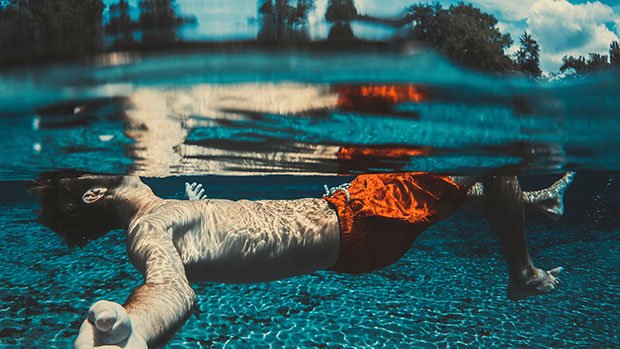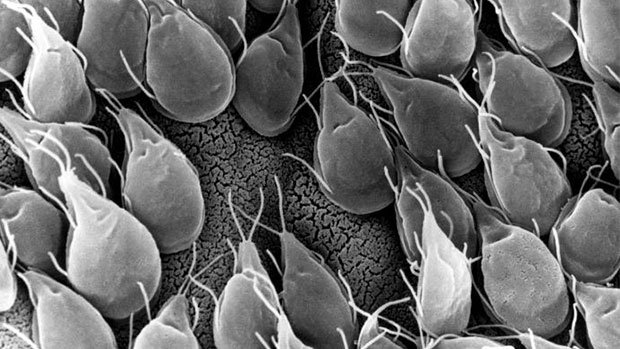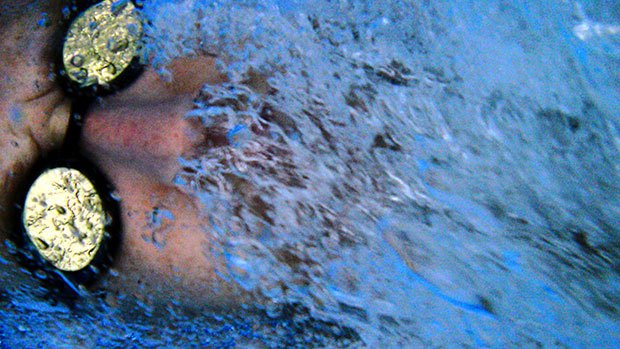What’s in your swimming pool?
Expert reviewers
Essentials
- Gastro-causing viruses, bacteria and parasites can live in swimming pools.
- Germs can be spread when water contaminated by poo is swallowed. While chlorine can keep germs at bay, it doesn’t kill them all immediately.
- Cryptosporidium and Giardia are extremely infectious parasites that are highly resistant to chlorine.
- While proper disinfection and maintenance of pools are essential, it’s also important to stop germs getting into the water in the first place.
‘Welcome to our ool. Notice there is no p in it. Let’s keep it that way.’
When I was a kid, that was the ubiquitous message nailed to nearby fences or on the toilet doors of houses of neighbours or friends lucky enough to have a backyard pool (sorry—ool). A plea to keep the germs out, to keep their pristine, chlorinated water sparkling clean. But, when it comes to the germs in our pools, it turns out that a yellow current isn’t the worst of our worries. Not by a long shot.

Germs, germs, germs
So how do they get into the water? Obviously not by leaping from the diving board or clambering down the poolside ladder. Rather, they get there by hitching a ride—on us. The way many of these germs are spread from person to person in swimming pool water is via faecal transmission—in other words (prepare for the ew factor), by people swallowing water that’s had poo in it.
These bugs live and multiply happily in an infected person’s gastrointestinal tract and are excreted in their poo. Not surprisingly when you think about it, there are actually small amounts of poo on most people’s bottoms—about 0.14 grams of faeces on average, according to the United States’ Centers for Disease Control and Prevention. Poo gets washed from their skin into the water, and the contaminated water is then swallowed by other swimmers, transferring the germs to their bodies. More drastically, a baby or toddler might poo in the water (what the World Health Organization rather euphemistically calls an accidental faecal release, or AFR), small amounts of which may then be swallowed by other swimmers. If you’re pretty sure you don’t swallow the water when you swim, a 2006 study found that, during a 45-minute swim, adults swallowed, on average, 37 millilitres—that’s almost two tablespoons. Children swallowed twice that amount. Once swallowed, germs live in their new host’s gastrointestinal tract until they’re pooed out, beginning the cycle again.
The tough guys: Cryptosporidium and Giardia
If all this has you swearing never to go in a swimming pool again, don’t worry—viruses and bacteria are controllable by proper, regular disinfection regimes, including chlorination. Of course, if there’s been an ‘AFR’ (or if someone has vomited in the water), normal disinfectant won’t be enough to keep germs under control. The contaminated area may need an extra dose of chlorine; the pool may need to be emptied, disinfected and refilled; or the whole pool may need to be closed and superchlorinated GLOSSARY superchlorinatedthe addition of large amounts of chlorine to disinfect the pool in a short period of time .
Nevertheless, when it comes to the germs in your pool, there are two which are particularly tenacious. These are the single-celled parasites Cryptosporidium and Giardia, and they’re the leading cause of pool-related gastro in Australia and beyond. If you’re unfortunate enough to swallow water contaminated with either, you may experience a range of symptoms including diarrhoea, bloating, fever, nausea and vomiting. All this is pretty unpleasant, and severe diarrhoea poses the danger of dehydration (especially in children or pregnant women). It can be particularly dangerous—even fatal—for people with compromised immune systems: those who are undergoing chemotherapy or have AIDS, for example. While Cryptosporidium and Giardia can be spread by various means, water is the most common way they’re transferred from person to person.

Cryptosporidium and Giardia are highly infectious. Just one person with Cryptosporidium can pass enough germs to contaminate a large pool, and you don’t need to swallow much contaminated water to become ill. To put some numbers on it, an infected person can shed up to 100 million Cryptosporidium germs in one bowel movement—and you only have to swallow 10 germs to get sick. To look at it another way, one infected bowel movement could infect the whole of New York. Thanks to a hard outer casing, both Cryptosporidium and Giardia can live outside the body for long periods (weeks, or even months in a moist environment), and Cryptosporidium in particular is highly resistant to chlorine.
Is chlorine enough?
So, is chlorine enough to keep our swimming pools safe? There’s no doubt it’s a necessity when it comes to keeping bacteria and viruses at bay. Indeed, outbreaks of water-borne disease in recreational swimming pools due to faecally derived viruses and bacteria have generally been associated with inadequately chlorinated or non-chlorinated water. In addition to chemical means, such as adding chlorine- or bromine-based disinfectants, pathogenic microorganisms can also be inactivated by physical methods, such as treatment with UV radiation.
Many people think that chlorine kills germs instantly. In fact, this isn’t the case. It actually takes different times for the same amount of chlorine to work, depending on the microorganism. Chlorine will kill bacteria such as E. coli in under a minute, but around 16 minutes to kill the hepatitis A virus. It’ll need 45 minutes to kill Giardia, and (wait for it) up to 10 days to kill Cryptosporidium.

So, does all this mean a few laps at the local are off the to-do list? Not necessarily. But it does mean that we all need to take responsibility for keeping germs out of the pool in the first place, by taking a few commonsense measures like:
- staying out of the water if we’ve recently had diarrhoea
- taking small children for frequent loo stops
- having a shower before going in the pool
- using swim nappies for babies who are going in the pool, and changing them often (in the change room, not poolside).
Worried about wee?
While it used to be thought that urine was sterile, it’s now known to contain bacteria—and high levels of bacteria in people with urinary tract infections, which are very common. However, it’s unlikely you’ll get sick from swimming pool water that’s had wee in it as the bacteria in urine are likely to be highly susceptible to chlorine.
Wee in your pool can cause other problems, however, which, in turn, can allow bugs to flourish. When the ammonia in urine reacts to chlorine, free chlorine is used up, contributing to the creation of chemical irritants called chloramines. Not only do chloramines reduce chlorine’s effectiveness, they can also make us sneeze, sniffle and cough. If you’ve ever found yourself with streaming eyes or a runny nose at the pool, chloramines are probably the reason.
The strong smell which you might have encountered at some pools which we tend to think of as ‘chloriney’ (and may assume is a good thing, a sign that the pool has this germ-busting business down pat) is actually not the smell of chlorine, but of chloramines. It’s a sign that there’s a fair amount of muck (including urine and sweat) going into that pool.
Take home message? Check out your public pools, and choose one that doesn’t have a strong chlorine smell.
And, if you’re worried about germs, make sure you find a public pool that’s well maintained, and has showers and baby change areas. It’s also a good idea if it has a separate swimming area for babies and toddlers; if there is an AFR, the offending pool will be able to be emptied out and treated.
If you have your own pool, you have a responsibility to maintain it so that it does not present a health hazard to those enjoying an afternoon's splash.
And wherever you swim—don’t drink the water.





